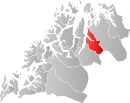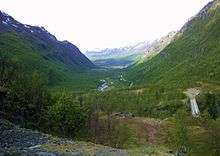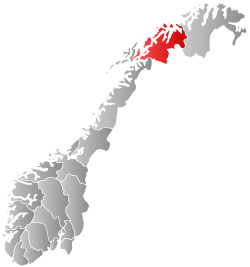Gáivuotna–Kåfjord
| Kåfjord kommune Gáivuona suohkan | |||
|---|---|---|---|
| Municipality | |||
|
| |||
| |||
 Kåfjord within Troms | |||
| Coordinates: 69°36′14″N 20°31′57″E / 69.60389°N 20.53250°ECoordinates: 69°36′14″N 20°31′57″E / 69.60389°N 20.53250°E | |||
| Country | Norway | ||
| County | Troms | ||
| District | Nord-Troms | ||
| Administrative centre | Olderdalen | ||
| Government | |||
| • Mayor (2003) | Bjørn Inge Mo (Ap) | ||
| Area | |||
| • Total | 991.10 km2 (382.67 sq mi) | ||
| • Land | 950.24 km2 (366.89 sq mi) | ||
| • Water | 40.86 km2 (15.78 sq mi) | ||
| Area rank | 106 in Norway | ||
| Population (2012) | |||
| • Total | 2,210 | ||
| • Rank | 315 in Norway | ||
| • Density | 2.3/km2 (6/sq mi) | ||
| • Change (10 years) | -5.7 % | ||
| Demonym(s) | Kåfjording[1] | ||
| Time zone | CET (UTC+1) | ||
| • Summer (DST) | CEST (UTC+2) | ||
| ISO 3166 code | NO-1940 | ||
| Official language form | Bokmål and Sami | ||
| Website |
www | ||
|
| |||
Gáivuotna (Northern Sami) or Kåfjord (Norwegian), (also Kven: Kaivuono) is a municipality in Troms county, Norway. The administrative centre of the municipality is the village of Olderdalen. Other villages include Manndalen, Birtavarre, Trollvik, Samuelsberg, Nordmannvik og Djupvik.
General information

The municipality of Kåfjord was established in 1929 when it was separated from the municipality of Lyngen. The initial population of Kåfjord was 2,482. Then on 1 January 1992, the Nordnes area of Lyngen (population: 38) was transferred to Kåfjord.[2]
Name
Kåfjord is a Norwegianized form of the Sámi name Gáivuotna. The meaning of the first element is unknown and the last element is vuotna which means "fjord".
The name of the municipality was Kåfjord until 2 May 1994, when it was changed to Gáivuotna–Kåfjord[3] It was the fifth municipality in Norway to get a Sami name. In 2005, the name was again changed such that either the Sami Gáivuotna or the Norwegian Kåfjord name can be used.[4]
Coat-of-arms
The coat-of-arms is from 1988. It shows a silver spinning wheel on a red background. This was chosen to reflect the crafts and traditions of the local community.[5]
Churches
The Church of Norway has one parish (sokn) within the municipality of Gáivuotna–Kåfjord. It is part of the Nord-Troms deanery in the Diocese of Nord-Hålogaland.
| Parish (Sokn) | Church Name | Location of the Church | Year Built |
|---|---|---|---|
| Kåfjord | Kåfjord Church | Olderdalen | 1949 |
| Birtavarre Chapel | Birtavarre | 1937 |
History
In 1945, the villages of Kåfjord were burned to the ground during the retreat of German forces from Finland and Finnmark. This was as far west as the Wehrmacht used their scorched earth tactics.
Government
All municipalities in Norway, including Kåfjord, are responsible for primary education (through 10th grade), outpatient health services, senior citizen services, unemployment and other social services, zoning, economic development, and municipal roads. The municipality is governed by a municipal council of elected representatives, which in turn elect a mayor.
Municipal council
The municipal council (Kommunestyre) of Kåfjord is made up of 17 representatives that are elected to every four years. Currently, the party breakdown is as follows:[6]
| Party Name | Name in Norwegian | Number of representatives | |
|---|---|---|---|
| Labour Party | Arbeiderpartiet | 5 | |
| Progress Party | Fremskrittspartiet | 1 | |
| Conservative Party | Høyre | 2 | |
| Christian Democratic Party | Kristelig Folkeparti | 2 | |
| Green Party | Miljøpartiet De Grønne | 1 | |
| Centre Party | Senterpartiet | 4 | |
| Local Lists | Lokale lister | 2 | |
| Total number of members: | 17 | ||
Geography

The municipality is situated on the eastern side of the Lyngen fjord, and around its eastern arm, the Kåfjord. The municipal centre is Olderdalen. Other villages include Birtavarre, Kåfjorddalen, Djupvik, Nordmannvik, and Manndalen, where the international indigenous peoples' festival Riddu Riđđu is hosted each year.
On the border with Finland, is the mountain Ráisduattarháldi which has a height of 1,365 m (4,478 ft).
Economy
Fishing and small-scale farming have been the most important sources of income. Now many people work in education and other public services. The population has declined for many years, but the decline is now less rapid than earlier. A new optimism has arisen among young people, largely due to the increasing cultural activities.
Population
The majority of the population is of Sami origin. Due to assimilation pressure from the Norwegian State, the language was largely lost in the 20th century. Now efforts are being made to reintroduce Sami, largely concentrated in the municipality's largest village, Manndalen/Olmmáivággi.
Notable residents
Erik Johnsen (1844–1941), a Laestadian preacher. He received the King's Medal of Merit (Kongens Fortjenstmedalje) in 1938 for his work for the salvation of the soul.[7]
References
- ↑ "Navn på steder og personer: Innbyggjarnamn" (in Norwegian). Språkrådet. Retrieved 2015-12-01.
- ↑ Jukvam, Dag (1999). "Historisk oversikt over endringer i kommune- og fylkesinndelingen" (PDF) (in Norwegian). Statistisk sentralbyrå.
- ↑ "Ot.prp. nr. 111 (2001-2002)" (in Norwegian). regjeringen.no. Retrieved 2008-12-02.
- ↑ "Endring av skrivemåten for tospråklige kommunenavn" (in Norwegian). Archived from the original on March 28, 2014. Retrieved 2008-12-02.
- ↑ Store norske leksikon. "Gáivuotna/Kåfjord" (in Norwegian). Retrieved 2012-12-20.
- ↑ "Table: 04813: Members of the local councils, by party/electoral list at the Municipal Council election (M)" (in Norwegian). Statistics Norway. 2015.
- ↑ Read more about Erik Johnsen
External links
| Wikimedia Commons has media related to Kåfjord. |
![]() The dictionary definition of gáivuotna–kåfjord at Wiktionary
The dictionary definition of gáivuotna–kåfjord at Wiktionary
![]() Troms travel guide from Wikivoyage
Troms travel guide from Wikivoyage

